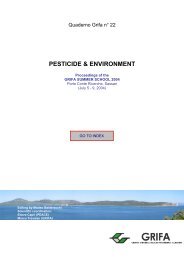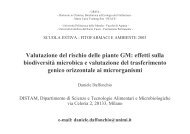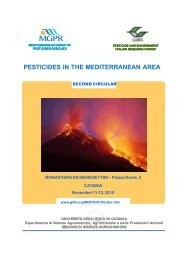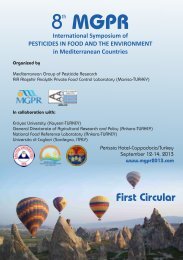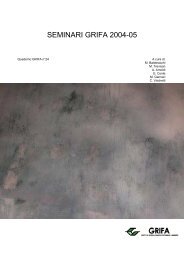International Congress BIOLOGICAL PRODUCTS - Gruppo di ...
International Congress BIOLOGICAL PRODUCTS - Gruppo di ...
International Congress BIOLOGICAL PRODUCTS - Gruppo di ...
Create successful ePaper yourself
Turn your PDF publications into a flip-book with our unique Google optimized e-Paper software.
10<br />
NEMATICIDAL ACTIVITY OF AQUEOUS EXTRACTS FROM RUE (RUTA GRAVEOLENS L.)<br />
T. D’Addabbo and N. Sasanelli<br />
Istituto per la Protezione delle Piante- Cnr, Sezione <strong>di</strong> Bari<br />
Via G. Amendola 165/A – 70126 Bari. Italy<br />
E-mail: nematd12@area.ba.cnr.it<br />
Summary. The effect of leaf and root aqueous crude extracts and of root leachates of R. graveolens on the root-knot<br />
nematodes Meloidogine arenaria, M. hapla, M. incognita and M. javanica, and on the beet cyst nematode Heterodera<br />
schachtii was investigated in a in vitro experiment. Aqueous extracts were prepared by soaking green leaves or roots in<br />
<strong>di</strong>stilled water and root leachates were collected by drenching the rue cultivated soil with excess tap water. Egg masses<br />
of each Meloidogyne species and cysts of H. schachtii were incubated in the test solutions over a four weeks period.<br />
Immersion in rue extracts significantly suppressed juvenile emergence from the egg masses of all the four<br />
Meloidogyne species and from cysts of H. schachtii. Leaf extract was always more effective than root extract for<br />
Meloidogyne species, whereas no <strong>di</strong>fference resulted in H. schachtii. No synergic effect derived from the combination<br />
of the two extracts. No significant emergence reduction resulted from the immersion in rue root leachates for any of the<br />
tested nematode species.<br />
INTRODUCTION<br />
Several plants are reported to minimize nematode damage in vegetable and field crops by producing nematicidal<br />
(killing) and nematistatic (suppressive) organic compounds. These natural compounds can be released from the roots of<br />
living plants or by plant tissues incorporated into the soil as a green manure (Grainge and Ahmed, 1988).<br />
The biocidal effect of extracts from rue (Ruta graveolens L.) was previously reported on insects, fungi and weeds<br />
(Aliotta et al., 1994; 1999; Oliva et al., 1999), but few information is available on the effect on phytoparasitic<br />
nematodes. Therefore an experiment was undertaken to investigate the in vitro effect of leaf and root aqueous extracts<br />
and of root leachates of R. graveolens on four <strong>di</strong>fferent species of root-knot nematodes, Meloidogine arenaria (Neal)<br />
Chitw., M. hapla Chitw., M. incognita (Kofoid et White) Chitw.and M. javanica (Treub) Chitw. and on the beet cyst<br />
nematode Heterodera schachtii Schmidt.<br />
MATERIALS AND METHODS<br />
Aqueous extracts of rue were prepared by soaking 100 g green leaves or roots, or 50 g when in combination, in 400 ml<br />
<strong>di</strong>stilled water for 24 hrs. Tissues were then macerated in a blender and the suspension filtered through filter paper.<br />
Root leachates were collected from three month old plants, cultivated in fifteen 2,500 cm 3 clay pots, by drenching the<br />
soil with excess tap water. The leachates were then centrifuged at 1,300 g for 30 min, stored in plastic bottles, and kept<br />
in a freezer until required. In the experiment on H. schachtii each plant extract or root leachate was adjusted to 3 mM<br />
ad<strong>di</strong>ng an equal volume of 6 mM of zinc sulphate (Clarke and Shepherd, 1966).<br />
The four Meloidogyne populations were reared on tomato cv. Roma in a glasshouse at 20-25 °C, whereas H. schachtii<br />
was collected from an infested field at Avezzano (L’Aquila). Batches of twenty egg masses (averaging 20,000 eggs per<br />
mass) of each Meloidogyne species or 100 cysts of H. schachtii (123 egg/cyst) were placed on 2 cm <strong>di</strong>am sieves (215<br />
µm aperture) and each sieve in a 3.5 cm <strong>di</strong>am Petri <strong>di</strong>sh. Three ml of each test solution, were then added to four batches<br />
of egg masses or cysts. Distilled water (for Meloidogyne species) or 3 mM zinc sulphate solution (for H. schachtii) and<br />
a 5 µg/ml aqueous solution of fenamiphos were used as controls.<br />
The <strong>di</strong>shes were arranged in a complete randomized block design with four replicates of each treatment: egg masses of<br />
Meloidogyne species were incubated at 25 °C, whereas the cysts of H. schachtii were mantained at 20 °C. Emerging<br />
juveniles were removed and counted at weekly intervals, renewing the hatching solutions at the same time, over a nine<br />
or ten weeks period, respectively for Meloidogyne species and H. schachtii. Egg masses and cysts were removed from<br />
the test solutions after the first four weeks and the incubation continued in <strong>di</strong>stilled water or, for cysts of H. schachtii, in<br />
the zinc sulphate aqueous solution.<br />
At the end of the experiment the egg masses were immersed in a 1% so<strong>di</strong>um hypochlorite aqueous solution (Hussey and<br />
Barker, 1973), whereas the cysts were crushed, accor<strong>di</strong>ng to Seinhorst and Den Ouden (1966). Unhatched eggs from<br />
egg masses and cysts were then counted. Numbers of juveniles emerging weekly were expressed as cumulative percent<br />
of the total initial population. Data were statistically analysed and compared by LSD’s test.<br />
PDF creato con FinePrint pdfFactory versione <strong>di</strong>mostrativa http://www.secom.re.it/fineprint<br />
69



